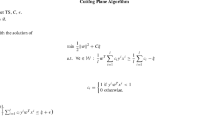Abstract
Support Vector Machines Regression (SVMR) is a learning technique where the goodness of fit is measured not by the usual quadratic loss function (the mean square error), but by a different loss function called the ∈-Insensitive Loss Function (ILF), which is similar to loss functions used in the field of robust statistics. The quadratic loss function is well justified under the assumption of Gaussian additive noise. However, the noise model underlying the choice of the ILF is not clear. In this paper the use of the ILF is justified under the assumption that the noise is additive and Gaussian, where the variance and mean of the Gaussian are random variables. The probability distributions for the variance and mean will be stated explicitly. While this work is presented in the framework of SVMR, it can be extended to justify non-quadratic loss functions in any Maximum Likelihood or Maximum AP osteriori approach. It applies not only to the ILF, but to a much broader class of loss functions.
Preview
Unable to display preview. Download preview PDF.
Similar content being viewed by others
References
T. Evgeniou, M. Pontil, and T. Poggio. Regularization networks and support vector machines. Advances in Computational Mathematics, 13:1–50, 2000.
F. Girosi. Models of noise and robust estimates. A.I. Memo 1287, Artificial Intelligence Laboratory, Massachusetts Institute of Technology, 1991. ftp://publications.ai.mit.edu/ai-publications/1000-1499/AIM-1287.ps.
F. Girosi. An equivalence between sparse approximation and Support Vector Machines. Neural Computation, 10(6):1455–1480, 1998.
F. Girosi, M. Jones, and T. Poggio. Regularization theory and neural networks architectures. Neural Computation, 7:219–269, 1995.
P.J. Huber. Robust Statistics. John Wiley and Sons, New York, 1981.
G.S. Kimeldorf and G. Wahba. Acor respondence between Bayesian estimation on stochastic processes and smoothing by splines. Ann. Math. Statist., 41(2):495–502, 1971.
M. Pontil, S. Mukherjee, and F. Girosi. On the noise model of support vector machine regression. A.I. Memo 1651, MIT Artificial Intelligence Lab., 1998. ftp://publications.ai.mit.edu/ai-publications/1500-1999/AIM-1651.ps.
V. Vapnik. The Nature of Statistical Learning Theory. Springer, New York, 1995.
V. Vapnik, S.E. Golowich, and A. Smola. Support vector method for function approximation, regression estimation, and signal processing. In M. Mozer, M. Jordan, and T. Petsche, editors, Advances in Neural Information Processing Systems 9, pages 281–287, Cambridge, MA, 1997. The MIT Press.
V. N. Vapnik. Statistical Learning Theory. Wiley, New York, 1998.
G. Wahba. Splines Models for Observational Data. Series in Applied Mathematics, Vol. 59, SIAM, Philadelphia, 1990.
Author information
Authors and Affiliations
Editor information
Editors and Affiliations
Rights and permissions
Copyright information
© 2000 Springer-Verlag Berlin Heidelberg
About this paper
Cite this paper
Pontil, M., Mukherjee, S., Girosi, F. (2000). On the Noise Model of Support Vector Machines Regression. In: Arimura, H., Jain, S., Sharma, A. (eds) Algorithmic Learning Theory. ALT 2000. Lecture Notes in Computer Science(), vol 1968. Springer, Berlin, Heidelberg. https://doi.org/10.1007/3-540-40992-0_24
Download citation
DOI: https://doi.org/10.1007/3-540-40992-0_24
Published:
Publisher Name: Springer, Berlin, Heidelberg
Print ISBN: 978-3-540-41237-3
Online ISBN: 978-3-540-40992-2
eBook Packages: Springer Book Archive




